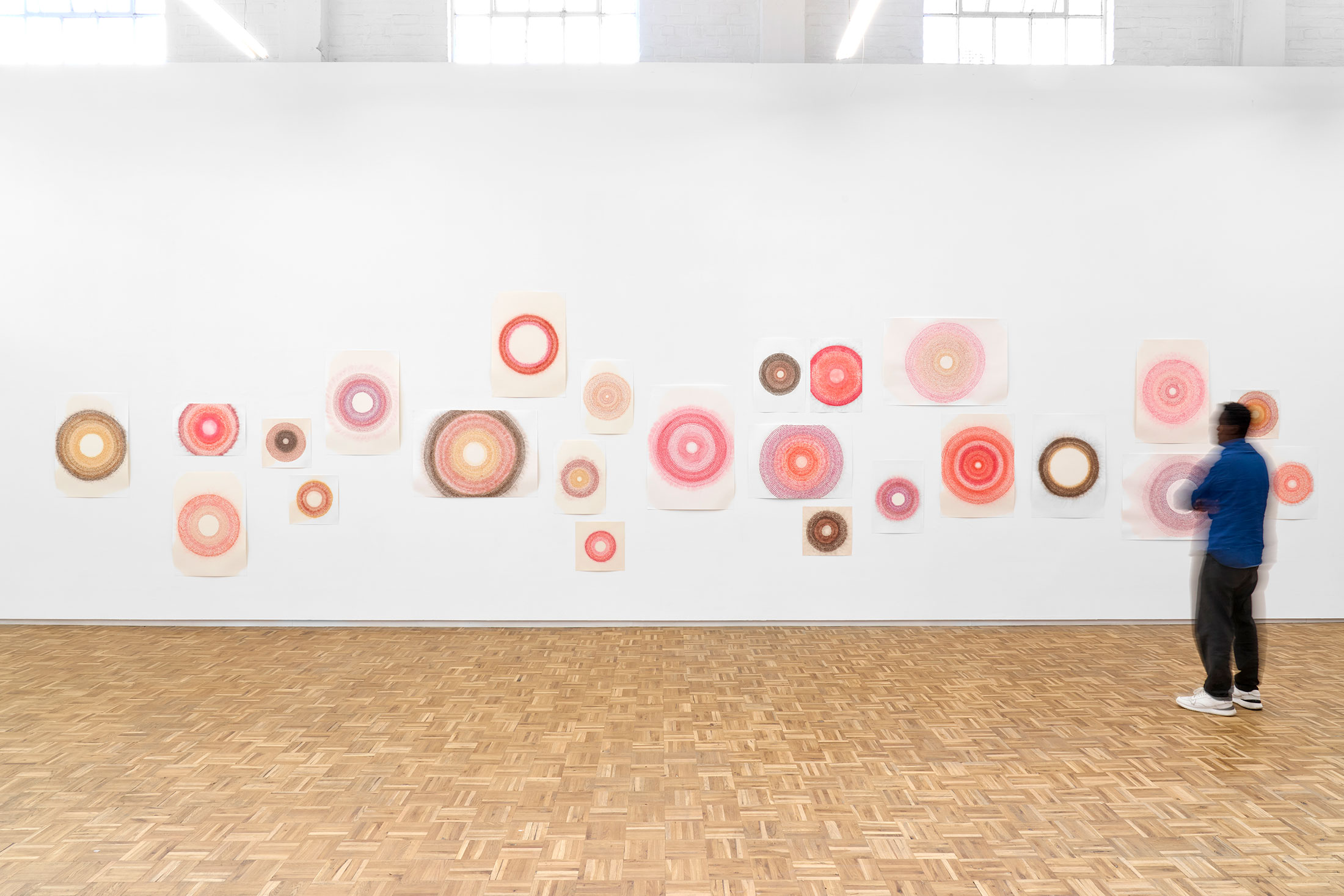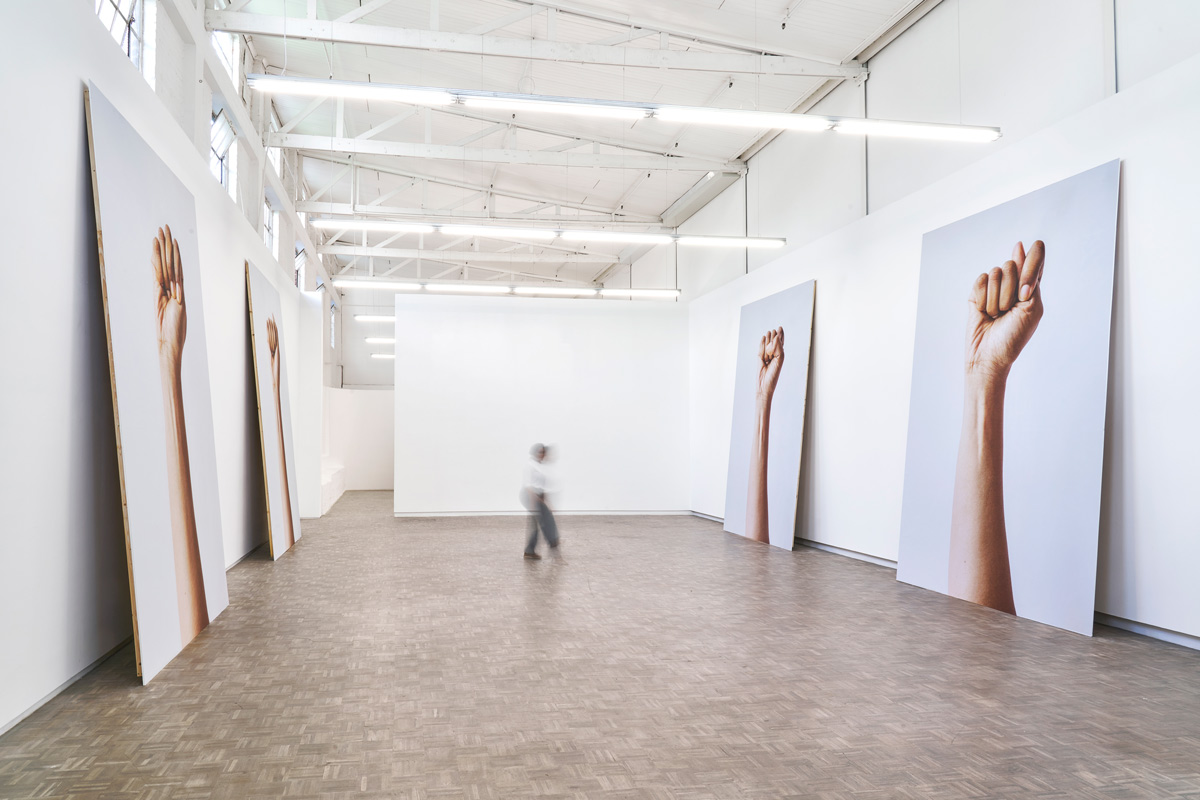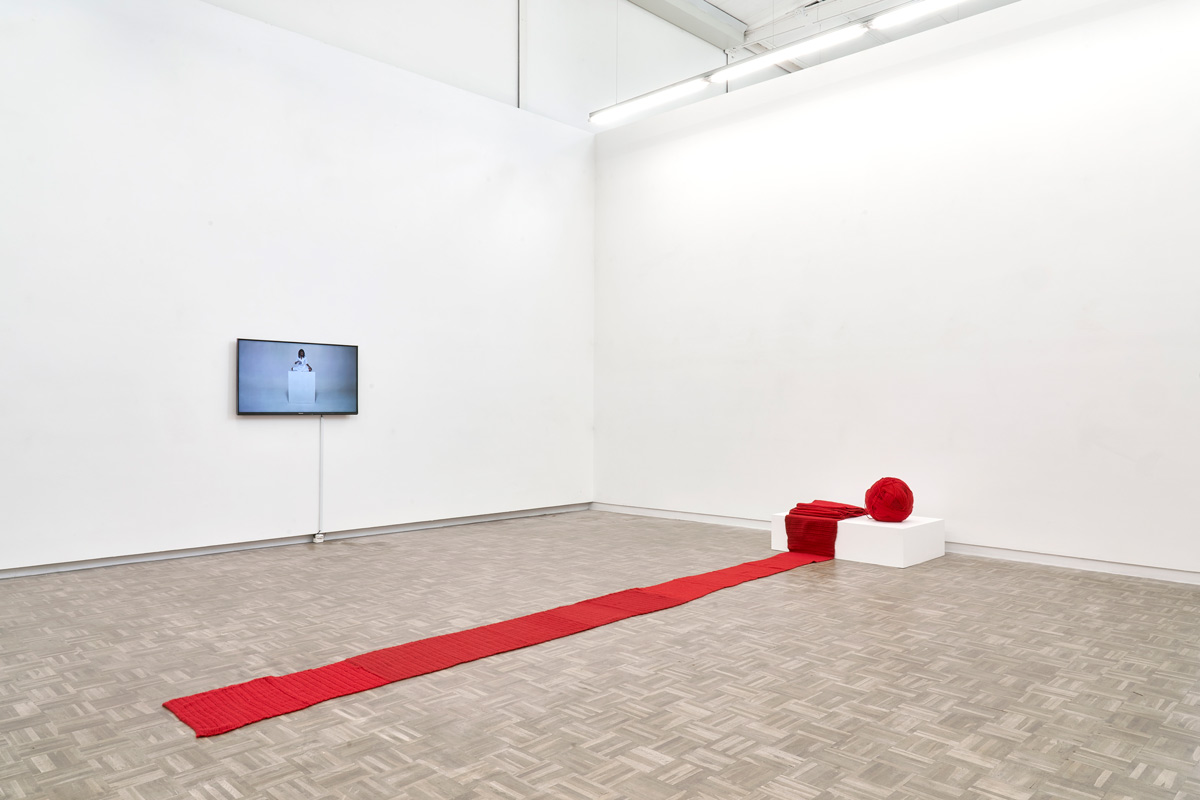









blank is pleased to present Tsela e e motsopodia, a solo exhibition by Lerato Shadi.
-
What’s a [Black] body got to do with it?: Brief notes on Lerato Shadi
By Vusumzi Nkomo
Value has to come from somewhere. If not labor, then from somewhere else—risk, temporality, circulation, and so forth.
– Alison Shonkwiler, The Financial Imaginary:
Economic Mystification And The Limits Of Realist Fiction1
Economic Mystification And The Limits Of Realist Fiction1
Black language needs to be a different kind of language, it needs to be an anti-language […], it needs to start where language ends or becomes impossible.
– David S. Marriott, S Marriott
in conversation with Frank Wilderson III2
in conversation with Frank Wilderson III2
In the work of Lerato Shadi (b. Mafikeng, South Africa), we witness an encounter between the body, work (or more precisely labour) and history. Through primarily performance, installation and video, this body, a Black woman’s body, is put to work in service of an extended inquiry into the constitutive relation between power and history, that is, how history is always fundamentally a question of power and that power is necessarily historical.
This labouring Black woman’s body, placed on plinths and pedestals, reveals the structure of racially gendered domination and its relations to art’s institutionality and the domain of the aesthetic writ large3. Shadi takes seriously the entanglements between artistic production and globalised circuits of racialized labour and commodity production within the context, first and foremost, of the longue durée of South Africa’s history of racial slavery, White settler colonial conquest, apartheid and its afterlives. Take Tlhogo (2010), a work that echoes Shadi’s contemporaries such as Bernie Searle’s Colour Me Series (1998), Tracey Rose’s Span II (1997), and less formally but more politically, the devastating politics of the practice of Senzeni Marasela4. Tlhogo (2010), like these fellow travellers who too wait and endure the cruelty of the spatio-temporal logics of an anti-Black world, is about the stakes of embodiment and social death. These violent processes almost descend, with all the full force of history, on the body. Shadi’s practice is organized around a consistent and concentrated set of political concerns that range from Blackness’ relation to labour, knowledge production and language, history and memory, subjectification and subjection, performativity and time, repetition and seriality.
In Mosako wa Nako (2014), for instance, Shadi is seen with a red ball of wool, the work’s raw material from which she pulls from, the “somewhere” from which value emerges, to follow Shonkwiler in the epigraph above. This simple gesture stands in stark contradiction to the fictions of capitalist modernity and its tendency to obfuscate sources of value and wealth. It bears mentioning that wool as material recalls the history of its production and centrality in the Cape Colony’s economy and according to historian JA Henry, “before the discovery of diamonds and gold, the entire economy of the Cape was carried on the sheep’s back”5.
Shadi’s practice, or more precisely her discourse, could be located at the critical point where Blackness exceeds language, pushes beyond the boundary of what can be said, where speech fails to symbolize, or more colloquially, represent (something). Speech or speaking, the domain of the conscious subject of cognition, is exposed as fundamentally lacking. This is strikingly evident in her text works, where there is a push and pull between legibility and illegibility, writing and erasure, forward motion and reversal. In these texts and incoherent sentences, it is less the structural integrity of the sayable (the what), nor the subject(s) of address and enunciation (the who) as much as it is what we might loosely describe as the register (i.e, the how); how are we going to say the things we think and feel, and those that are unthought and we are yet to feel. These works refuse grand political statements but retreat into the impossibly impenetrable abstraction, a swerving line, indeterminately beautiful line.
In Shadi’s performances there is hardly any talking or dialogue (the closest being song), but ‘pure’ unmediated activity. The statement is the act, immediate and vanishing. Perhaps this is what’s appealing to Shadi about performance despite its concreteness as an event; that it always recedes and resists (not escape) spectatorial capture, what Peggy Phelan, in the seminal chapter The ontology of performance: representation without reproduction6, called “performance’s being”, its very ontology, “becomes itself through disappearance”7. That is, at its most radical, performance is only when it is not (or no longer). This was the disruptive intervention of event oriented practices that refused the fetishistic relation to the object by the art market.
Further, Shadi’s performances are a focused and profound engagement with time; her giving up her time to carry out this or that task, not unlike how one gives up or trades one’s labour time in the marketplace. (We could think here of the late artist Pope L who reminded us that what bonds performance and language is nothing other than “duration”8). Time, as our capitalist modern order’s prized possession, is numbingly explored by Shadi through the strategy of repetition. This repetition compulsion is the reenactment of the structuring lack constitutive of subjectivity, that is, repeating the primal scene not unlike how trauma victims return to and reproduce the fundamental traumatism.
Shadi’s labouring on repetition as tool and motif (a banal ‘formal’ strategy) is a critical exposition of the manner in which, say, historical ‘facticity’ is secured through repetition and safeguarded as stable meaning or problematic normativity (be it Whiteness, or more precisely non-Blackness, heteronormativity, capitalist patriarchy, conservatism, fascism etc). In another register, to repeat is to remember against generalized wilful amnesia, to remember that “then and now coexist: we are coeval with the dead”. As Jacques Lacan once put it, “remembering always involves a limit”. If any, this might be the lesson from Shadi to us10: that, focused critical thinking necessarily entails that we learn the very limits of unlearning11.
1 Alison Shonkwiler, 2017. The Financial Imaginary: Economic Mystification And The Limits Of Realist Fiction. Minneapolis, London: University of Minnesota Press; pp. xxiii.
2 David Marriott, 2022. CITY LIGHTS LIVE! DS Marriott in conversation with Frank Wilderson III. [Online]. Available here: https://youtu.be/Mw20cLg-iic
3 For a sustained engagement with this entanglement, see Rizvana Bradley, 2023. Anteaesthetics: Black Aesthesis and the Critique of Form. Stanford: Stanford University Press.
4 I have in mind, on the one hand, the language of performance and formal grammar of the colour red (from the red thread Marasela uses, to the red dresses she wears) and, on the other, Marasela’s ethic of endurance through her durational work in ‘projects’ such as Waiting for Gebane.
5 Cited in Richard Steyn, 2024. Rhodes And His Banker: Empire, Wealth And The Coming Of Union. Jonathan Ball Publishers; pp. 1.
6 From her 1993 book Unmarked: The Politics of Performance. London and New York: Routledge.
7 Ibid., 146.
8 See Pope.L. is Making a Commitment to Art | Louisiana Channel [Online]. Available here: https://youtu.be/kTs5QkK20M4
9 Saidiya Hartman, 2002. The Time of Slavery, in The South Atlantic Quarterly 101:4; pp. 759.
10 I say “if any” because it doesn’t seem Shadi is in the business of handing down lessons!
11 The idea of ‘unlearning’ is cheaply thrown around in our liberal multicultural times and requires the greatest political vigilance.
-
Born in Mahikeng, South Africa, Shadi lives and works in Berlin, Germany. Her work has been included on numerous institutional exhibitions, including at the Bundeskunsthalle in Bonn, A4 Arts Foundation in Cape Town, Kunstmuseum Celle, Kunstmuseum Wolfsburg, Kunsthalle Münster, Museum of Fine Art, Chur, Switzerland, Musée d’Art Moderne de Paris, Neuer Berliner Kunstverein (n.b.k.), Daimler Contemporary, ifa-Galerie and SAVVY Contemporary in Berlin; Zeitz MOCAA in Cape Town; Kunsthal Amersfoort in the Netherlands; and the Tate Modern in London. She has also exhibited at the Curitiba Biennial in Brazil, the Moscow International Biennale for Young Art, and DAK’ART Dakar Biennale. She was awarded the Alumni Dignitas Award of the University of Johannesburg in 2016, the Villa Romana Prize in 2018, and the Berliner Senat Arbeitsstipendium in 2019. Her work is represented in the collections of the Tate Modern, n.b.k Videoforum, and IZIKO South African National Gallery, among others.











blank is pleased to present Di Sa Bonweng, a solo exhibition by Lerato Shadi. The exhibition includes a selection of works ranging from installation to performance and video. Di Sa Bonweng can be interpreted as 'the unseen', and in the context of Shadi's practice, the title opens up a multitude of potential meanings related to that which is invisible; those things that we cannot (or choose not to) see, either due to our intellectual biases or because they have been excluded from systems of knowledge production. Often comprised of Setswana words or phrases, her titles deliberately deny ready translation. For Shadi, they are both an assertion of her identity and a refusal to be 'understood' by the audience.
In I know what a closed fist means (2020), the artist interrogates universal assumptions by emphasising multivalent, subjective readings of her work. Four large-scale, floor to ceiling photographs depict raised fists with the position of the thumb in each image having a variety of associated meanings that differ depending on the viewer's own cultural background. The work's title is paradoxical in that it contradicts the endless possibility for interpretation of the individually raised fists - Shadi makes it clear that knowledge and experience are always connected to one's own perspective and cannot be easily generalised.
Shadi speaks of Mosako wa Nako as a red river. It is the product of 60 hours of labour, which Shadi carries out publicly over the course of 10 days. The 10-metre knitted object is rendered as a representation of silent narratives and acts as an architectural feature that divides the space. As M. Neelika Jayawardane states, "in highlighting work that is usually associated with feminised-and therefore often inconspicuous and devalued labour, Shadi focuses our attention to the meditative quality of her actions. Bringing the experience of meditation into her labour allows her to be present in her body and in the present moment-to-moment of labour, and for us, as her audience, to be similarly mindful in the space".1
For Shadi, the colour red has significance "in regard to its connection to corporeality and to violence." In her recent works, Series (2020), red knitted squares are sewn onto raw linen and mounted on canvas stretcher frames, referring to the tradition of panel painting, the history of which has been dominated by white male artists for centuries. Shadi's process involves preparing herself physically and mentally for the production of her work, in a kind of private, durational performance. She states, "my entire practice is a durational practice. The idea of durational works, the ideas of labour, the values of labour are also always present in my work."
Challenging common assumptions to critique Western notions of history, Shadi's work makes visible that which is invisible or overlooked. Often employing repetitive processes in her performances and video works, she argues the importance of centering - not just including - the marginalised body as a main figure of narrative experience. By placing herself at the forefront of her work, Shadi deals with the politics of cultural erasure and structural exclusion. According to Shadi, "it serves to challenge myself, and hopefully my audience as well, in how I/we are complicit in the violence of historical erasure by not fighting for a more inclusive and accurate historical narrative. I realised that - by just blindly or lazily accepting an inaccurate history - I would be sanctioning the problematic dominant narrative with my own inactivity."
1 The Beautiful Ones Will Not Be Erased, M. Neelika Jayawardane in conversation with Lerato Shadi, Albany History Museum, Makhanda (2016)
Born in Mahikeng, South Africa, Shadi lives and works in Berlin, Germany. Her work has been included on numerous institutional exhibitions, including at the Kunsthalle Münster; Museum of Fine Art, Chur, Switzerland; Musee d'Art Moderne de Paris; Neuer Berliner Kunstverein (n.b.k.), Berlin; Zeitz MOCAA, Cape Town; Kunsthal Amersfoort, Netherlands; and the Tate Modern, London. She has also exhibited at the Curitiba Biennial in Brazil and DAK'ART Dakar Biennale. In 2020, Shadi had solo exhibitions at the Kunstverein in Hamburg and KINDL Centre for Contemporary Art in Berlin. She was awarded the Alumni Dignitas Award of the University of Johannesburg in 2016, the Villa Romana Prize in 2018, and the Berliner Senat Arbeitsstipendium in 2019. Her work is represented in the collections of the Tate Modern, n.b.k Videoforum, and Iziko South African National Gallery, among others. In April 2022 her first monograph will be published with Archive Books, Berlin-Dakar-Milano.
Di Sa Bonweng is Shadi's first exhibition in South Africa in over five years, and in Cape Town in over a decade.
Exhibition press:
Krynauw, M. Moments before meaning: A conversation with Lerato Shadi. Artthrob [online] (published 2 May)